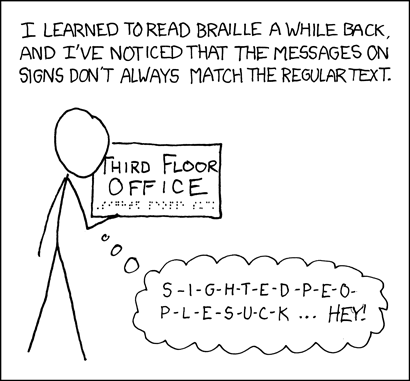315: Braille
| Braille |
 Title text: The only big difference I've seen is in colors. Where the regular text reads 'press red button', the braille reads 'press two-inch button'. |
Explanation
Braille is a writing system for the blind and visually impaired using bumps on a paper, slate, etc. However, since most sighted people have no need for braille, and because braille messages may need to convey purely-visual information to blind people, the braille message may be adjusted from the original message. In this case, however, it acts as a jab toward people who are not blind, saying that "sighted people suck," which is obviously not something you would typically see (no pun intended)[citation needed] on informational signs.[SIGHTation needed] Similar "translations" can be found when one deciphers the alien translations on nearly all signs in Futurama.
The title text shows a practical (and more realistic) example of where regular text and braille text may differ. As the visually impaired cannot see color, the label would need to identify some other defining feature of the button in question, such as the given measurement.
Transcript
- I learned to read braille a while back, and I've noticed that the messages on signs don't always match the regular text.
- [A sign reads "Third Floor Office" with braille print underneath. Cueball is reading the braille.]
- Cueball (thinking): s-i-g-h-t-e-d-p-e-o-p-l-e-s-u-c-k ... Hey!
Discussion
Don't know braille enough to sight-read (I know, but I certainly can't touch-read it, so I have to go on the visuals), but when I work out the cipher, each time, sometimes the 'translation' is revealed to be interesting, but more often than not there's a braille-enabled sign that doesn't seem to make sense in the first place. Mainly ones where the effort of finding the sign is probably a bigger handicap than dealing with what the sign says. "Push" on a 'next stop' button on a bus, that to me would seem obviously such a button if you make tactile contact with it in the first place (although the driver usually liaises with anyone with that sort of difficulty, anyway). "If you need any assistance, please ask" tacked down onto a reception desk, where any receptionist that is there would surely notice the blind person looking feeling around for such a 'handy' notice and so should intervene straight off the bat.
But the one that always gets me is the one that labels a WC's external light-switch. No other switches are labelled, around that area (nor anything else, save for the WC sign, high up on the door, surely difficult to examine or even imagine you should try to find to examine), and I can barely justify that sign by the possibility that a person might have bad sight in low light and have learnt braille to compensate, for which this is useful. But I just can't get past the thought that every reasonably sighted person and every 'reasonably blinded' person would have no use at all for the braille component, one way or another.
I stand to be corrected by anyone who knows better, of course. 178.98.31.27 20:32, 19 June 2013 (UTC)
Hope I'm not typing where I shouldn't be #noob but it would make more sense if cueball read "s-i-g-h-t-(ed) p-e-o-p-l-e s-u-c-k" 173.245.50.88 04:34, 29 January 2014 (UTC)noob
- If you want to go for grade 2, it gets much shorter than that: s-i-gh-t-ed p s-u-c-k ("p" alone is read as "people", and gh is also a two-letter sign). Silverpie (talk) 20:10, 15 May 2014 (UTC)
- @Silverpie: The comic does have ⠎⠊⠛⠓⠞⠫⠀⠏⠑⠕⠏⠇⠑⠀⠎⠥⠉⠅ which has g: ⠛ h: ⠓ yet ed: ⠫. 141.101.70.151 13:21, 31 July 2014 (UTC)
Maybe the reason for the braille sign on the WC light switch was so that the blind person (who couldn't see the light) would know that switch should be off when the WC isn't in use, and won't waste electricity).
In the U.S., it was common for places like the Post Office to have a sign saying that pet dogs were prohibited, but guide dogs for the blind were allowed. This was widely seen as silly, because a blind person wouldn't be able to read the sign. (The law has since been changed to allow all disabled persons to bring assistance animals in places where pets are prohibited.) However, including the exemption for the blind on the sign made sense. The point was so that a sighted person who read the sign would know about the exemption for the blind, and wouldn't tell a blind person not to bring a dog into the place. Sometimes there is a non-obvious explanation for something that seems silly, but really isn't.173.245.48.103 04:52, 30 June 2014 (UTC)
Nobody's mentioned the insanity of braille posted where only a driver could encounter it, like a drive-through ATM. I've also seen PRINTED SIGNS saying "braille menus for the seeing-impaired" posted, with no accompanying braille. —Kazvorpal (talk) 21:49, 5 November 2019 (UTC)
- Maybe because it is not insane. ATMs are usually not produced that specifically for a location, so it would be a lot of hassle to make the extra spec of an ATM *WITHOUT* Braille. Also especially a blind person might be using it while being assisted and sitting in a backseat on the driverside. Regarding the menus: If I go to dinner with my blind friend, and I see a sign like this, I can tell him, they got a Braille-menue and he is happy because he can read it himself without of me reading it to him or choosing for him. Also Braille is not only for the blind but also seeing-impaired, who might be comfortable reading a large printed sign, but not with a small print menu. --Lupo (talk) 07:20, 6 November 2019 (UTC)
